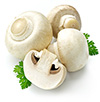Knowing the different types of mushrooms is crucial if you're picking your own (some poisonous mushrooms look similar to types used in cooking), but it is also helpful in the kitchen.
The most basic mushrooms are white/button mushrooms or the similar-looking brown mushrooms called cremini mushrooms or baby portobellos.


Other popular mushroom types include chanterelles, portobellos, morels, and in Asian cuisines, oyster, shiitake, and enoki mushrooms.






The prized truffle mushrooms—white and black—or mattake/matsutake mushrooms are the most expensive mushroom varieties.

Many mushrooms are also available dried. Dried porcini mushrooms, dried shiitake (also called Chinese black mushrooms), dried chanterelles, and dried morels must be soaked in water, and both the mushrooms and the soaking liquid can be used to make flavorful soups, stews, sauces, braises, stir fries, etc.1
Buy fresh mushrooms that are firm and not spotty or slimy and refrigerate for up to one week. Store dried mushrooms in an airtight container.
Good news for mushroom lovers: according to the Environmental Working Group (EWG), mushrooms are pretty "clean" when it comes to pesticide residue, so you do not have to splurge on extra-expensive organic mushrooms (unless you want to!)
Note: you might be wondering, should you wash mushrooms? Before you spend your precious time wiping down mushroom after mushroom with a towel, you should probably know that this is mostly a myth. While mushrooms can absorb a little water if you soak them long enough, the amount absorbed from a quick wash is not going to have much of an impact on your dish. So go ahead and wash them the easy way.
Sources
Nutrition DNA
The nutrition DNA of mushrooms. For example, you can see that 1 mushroom covers 5% of your daily need of Vitamin B2 and 4% of the recommended Vitamin B3 intake. Hover over the bars to see which nutrient is covered.





